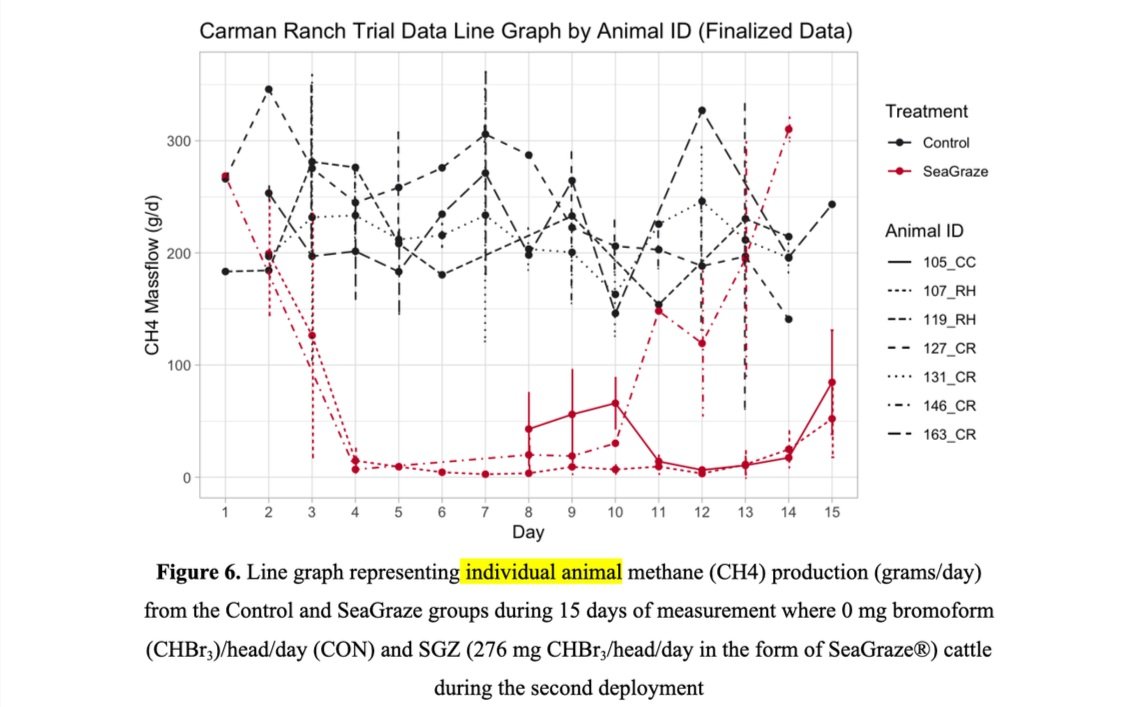Implementing SeaGraze® in Beef Pasture Systems: Achievements and Insights for Effective Deployment
Carman Ranch in Wallowa, OR was the first in the U.S. to introduce SeaGraze®, an Asparagopsis taxiformis feed additive, into their pasture-based beef system to assess methane (CH4) mitigation potential.
Thank you to our trial collaborators!
With the new pressures of becoming more sustainable, farmers now have a unique opportunity to enhance the sustainability of their practices and potentially benefit from the emerging carbon market through the incorporation of climate smart feed additives, like SeaGraze®.
The objective of this study was to evaluate the practicality and efficacy of introducing SeaGraze®, to beef cattle grazing on pasture. It was hypothesized that SeaGraze® could be introduced and voluntarily consumed enough to detect a significant difference in production of CH4 in comparison to a control group. Doses and introduction methods were explored.
Introduction
Reducing enteric methane emissions can be a quick, measurable solution.
Ensuring that technologies have direct measurement pathways is essential to creating new revenue pathways for farmers. Carman Ranch owner, Cory Carman, comments on the ability of SeaGraze® to fill this gap while the science around regenerative practices continues to build.
Materials and Data Collection
For the first part of this study, SeaGraze® at a low dose of 77.8 mg CHBr3/head/day was mixed in with beet pulp and provided to a group of 12 head of cattle and compared to an independently managed group that received no SeaGraze®.
Following initial data collection, a second study was then conducted to target higher methane reductions.
Modifications from the original design included a decrease in group sizes to 6 animals and increase in dose (276 mg CHBr3/head/day) with improvements to delivery of SeaGraze® voiding the use of beet pulp, and instead mixed with salt.
A group of 24 grazing cattle were organized and divided based on sex, arranged by weight, and assigned to two groups: either 1) Control (CON; no implementation of SeaGraze®) or 2) Treatment (SGZ; implementation of SeaGraze®) groups. The treatment was prepared in 5 gallon buckets to be administered as a 3-day supply, with 73 ± 7.7 mg CHBr3/head/day in the form of SeaGraze®.
A Pasture GreenFeed unit (C-Lock, Rapid City, SD) was used to measure carbon emission. The GreenFeed operates by sensing the RFID tags in the ears of individual animals and upon recognition, dispenses bait feed (grass pellets in this scenario) to incentivize animals to enter the head chamber. Flux technology inside the head chamber, pulls samples of breath from the animal and using sensitive gas sensors, quantifies carbon emissions.
Results
First Part of Study With Lower Dose
Baseline emissions between the control and experimental groups were not significantly different. Given that the SeaGraze® was administered with beet pulp, there was high competition for consumption and the low dose (77.8 mg/head/day) showcased an initial 27.2% reduction of CH4 compared to the control group.
In feed additive trials it is typical to consider the first 21 days as an adaptation period, meaning it may not be representative of the additives full potential. This data highlights how quickly, in just two weeks, SeaGraze can intervene with herd emissions.
Second Part of Study With Higher Dose
After establishing safety of the dose and too high of palatability with the beet pulp, a second portion of the study was administered with salt instead of beet pulp and a higher rate of inclusion. The second execution of the study increased the dose in the SGZ group to 276 mg CHBr3/head/day in the form of SeaGraze®. The initial inconsistency led to a 76.0% and 66.1% decrease in CH4 where initial variability was due to product inconsistency and closing variability due to one animal specifically choosing to consume less of the SeaGraze® product (below).
Early Insights into Animal Behavior and Pasture Supplementation
The voluntary setup of methane-mitigating additives in pasture settings will likely include variability within the herd due to the individual behavior of animals for taste preference and social hierarchy, driving some animals to eat more or less than their herd mates. Further research is needed; larger grazing studies should be conducted where cattle can be rotated under standard practices of the operation in order to assess feasibility for ranchers. As an initial look, reductions were promising that voluntary systems could work with proper carriers and access to all animals.
SeaGraze® is ideal for pasture-based systems.
Download full Carman Ranch Report Here









